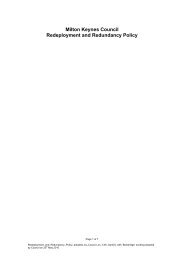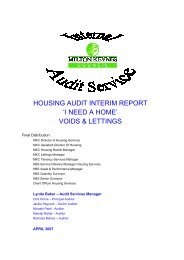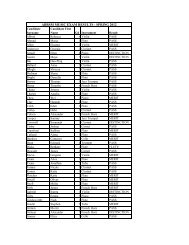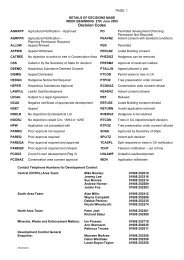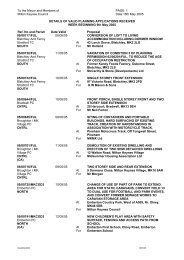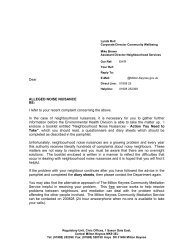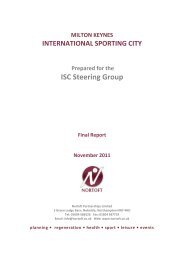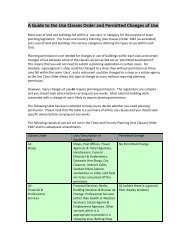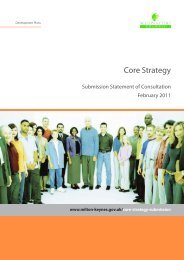No Joke! No Joke! - Milton Keynes Council
No Joke! No Joke! - Milton Keynes Council
No Joke! No Joke! - Milton Keynes Council
Create successful ePaper yourself
Turn your PDF publications into a flip-book with our unique Google optimized e-Paper software.
<strong>No</strong> <strong>No</strong> <strong>Joke</strong>!<br />
<strong>Joke</strong>!<br />
Domestic Abuse<br />
Schools’ Education Pack
3<br />
<strong>No</strong> <strong>Joke</strong>!<br />
This pack has been produced by the Thames Valley Partnership as part of the ‘<strong>No</strong> <strong>Joke</strong>’ programme<br />
funded by Comic Relief, with input from a range of professionals with specialist expertise in this field.<br />
With thanks to:-<br />
Pat Wallace – Breaking Free<br />
Julia Worms – Thames Valley Partnership<br />
Julia Kirkup – Thames Valley Partnership<br />
Marlborough, Cheney and Warriner Schools in Oxfordshire who worked closely with the project<br />
Sue Moss, Domestic Abuse Co-ordinator, Buckinghamshire<br />
Sophie Wing-King, Domestic Abuse Co-ordinator, East Berkshire<br />
Caroline Knowles, Domestic Abuse Co-ordinator, <strong>Milton</strong> <strong>Keynes</strong><br />
Liz Jones, Domestic Abuse Co-ordinator, Oxford City<br />
Michelle Plaisted-Kerr, Domestic Abuse Co-ordinator, Oxfordshire<br />
Louise Crow, Domestic Abuse Co-ordinator, Reading<br />
Jo McIntyre, Domestic Abuse Co-ordinator, West Berkshire<br />
Thames Valley <strong>No</strong> <strong>Joke</strong>! Consultancy Group and Comic Relief<br />
I N D E X<br />
Foreword – Domestic Abuse is <strong>No</strong> <strong>Joke</strong>! 4<br />
Section 1 - Introduction 5<br />
Section 2 – Importance of Addressing Domestic Abuse In Schools 6<br />
Section 3 – How To Use This Pack 8<br />
Section 4 – What Do We Know About Domestic Abuse? 9<br />
Section 5 – Impact of Domestic Violence on Children & Young People 14<br />
Section 6 – Domestic Abuse Dynamics 17<br />
Section 7 – Domestic Abuse and Adolescents<br />
Section 8 - Disclosure of Domestic Abuse<br />
Section 9 - Lesson Plans and Advice<br />
Additional Education Resources 27<br />
Useful References 27<br />
Local Information 28<br />
Page<br />
THIS DOCUMENT REMAINS THE PROPERTY OF THE THAMES VALLEY PARTNERSHIP AND<br />
COMIC RELIEF AND SHOULD ONLY BE REPRODUCED WITH EXPRESS PERMISSION<br />
20<br />
21<br />
25
<strong>No</strong> <strong>Joke</strong>!<br />
The invitation to be a contributor to this <strong>No</strong> <strong>Joke</strong>! programme was well received on<br />
my part since all teachers at my own school and other schools across the whole of the<br />
United Kingdom are committed to promote all that is good about human relationships.<br />
Domestic abuse and violence has a significant impact on adults, young people and children. The <strong>No</strong><br />
<strong>Joke</strong>! programme has given opportunities to adults and young people at our school to consider this<br />
social problem. Staff training has been facilitated and community links with expertise in this field of<br />
work have been expanded.<br />
Most importantly we have, where appropriate, embraced learning opportunities via Personal, Social<br />
and Health Education (PSHE) programmes and our regular Immersion Day learning events. The<br />
lesson plans within this pack tackle a number of issues associated with relationship education. Take a<br />
look at the summary grid within the pack – this useful overview may be helpful to other teachers who<br />
may be planning more learning about a subject that is a challenge to tackle in the classroom.<br />
Our starting point has been our commitment to helping young people to develop and value respectful<br />
relationships. Thanks to the <strong>No</strong> <strong>Joke</strong>! sponsors, Comic Relief, for supporting this programme<br />
and facilitating publication of this pack that will assist teachers and other professionals in their work.<br />
Pam Maynard<br />
Assistant Headteacher<br />
Marlborough School<br />
Woodstock<br />
Oxon<br />
Foreword<br />
Domestic Abuse is <strong>No</strong> <strong>Joke</strong>!<br />
4
5<br />
<strong>No</strong> <strong>Joke</strong>!<br />
Domestic abuse is a widespread social problem which can have both short-term and long-term<br />
damaging effects. It is becoming increasingly talked about by central government, and is appearing<br />
more in the media. Figures from the Thames Valley Police show a total of 26,837 domestic abuse<br />
incidents for the year from April 2008 to March 2009 1 . Studies across the country have shown the<br />
reporting of domestic violence incidents has increased over recent years, in some areas by over 30% 2 .<br />
Behind these figures are the ‘hidden victims’. An approximated 750,000 children at least witness<br />
domestic violence each year 3 , which can have a significant impact on their health and well-being.<br />
This pack gives you an overview of domestic<br />
violence and abuse and how it impacts on<br />
children and young people. It will enable you<br />
to understand the issues and how to deal with<br />
any disclosures. It will direct you to a range<br />
of flexible and tried and tested resources to be<br />
used in the classroom. It also gives details of<br />
local domestic abuse experts who will be able<br />
to assist you with any concerns.<br />
Section 1<br />
Introduction<br />
1 The Co-ordinated Community Response to Domestic Violence<br />
2 Thames Valley Police Performance figures, April 2008-March 2009<br />
3 Safer Bristol Press Release (2004)Department of Health (2002)<br />
This pack has been produced to address<br />
a gap in provision for schools and to<br />
help those working in education to raise<br />
awareness of domestic violence and<br />
promote healthy and respectful<br />
relationships. It also contains a<br />
directory of services in your area with<br />
additional support and resources you<br />
can access.<br />
Domestic abuse can be summarised as an abuse of power to exert control over another person.<br />
Controlling behaviour may not always be physical violence, which is why the terms ‘domestic<br />
violence’ and ‘domestic abuse’ can be used interchangeably.<br />
It is also important to note that in this pack, the perpetrator of domestic abuse maybe<br />
characterised as a male, and the victim as a female. Whilst research has proven that the majority<br />
of domestic violence is by men against women, it is also important to acknowledge that domestic<br />
abuse can also be perpetrated by women against men, or may occur in same-sex relationships.<br />
The definition can also include abuse perpetrated by several members of a family or by children on<br />
parents.
<strong>No</strong> <strong>Joke</strong>!<br />
Section 2<br />
Importance of Addressing Domestic Abuse in Schools<br />
Children and young people who witness or experience<br />
domestic abuse may be vulnerable to developing<br />
behavioural issues, attendance problems, ill health, antisocial<br />
behaviour (including bullying) and mental health<br />
issues particularly depression, self-harm or drug and<br />
alcohol misuse 4 . These types of behaviour can be very<br />
disruptive in a school environment, not only to the<br />
individual involved, but to those around them. Schools<br />
need to address these issues and it is important for them to<br />
be aware of the impact of domestic abuse which may<br />
underlie these behaviours. Research also shows that some<br />
children who are experiencing domestic abuse can<br />
alternatively be ‘model’ children or high achievers.<br />
Research has proven that early interventions with<br />
children and young people experiencing domestic<br />
abuse can have a huge positive impact in reducing<br />
or eliminating adverse long term behavioural or<br />
emotional difficulties. Schools play a key part in<br />
this work, as teachers have authority as a strong<br />
learning mentor and are able to challenge negative<br />
attitudes, or those promoting violent or abusive<br />
behaviours.<br />
Young people want to discuss and learn more about interpersonal and domestic abuse and their peers<br />
often provide an important source of support – talking together may be their preferred way of<br />
learning 5 or finding information. Lesson time can often be seen as a non-threatening, neutral<br />
environment where young people can express their opinions, which they may not feel as comfortable<br />
discussing with a parent/carer or other relative. Awareness training in schools can facilitate student<br />
knowledge about the impacts of domestic abuse and support services available, which in turn<br />
enhances their ability to provide good advice amongst their peers or in a peer mentoring capacity.<br />
4<br />
HM Government (2006) Working Together to Safeguard Children: A guide to inter-agency working to safeguard and<br />
promote the welfare of children<br />
5<br />
National Union of Teachers (2005) Silence is not always golden<br />
6
What Can Schools Offer?<br />
Disclosures<br />
7<br />
<strong>No</strong> <strong>Joke</strong>!<br />
• Create an environment for long-term prevention of domestic abuse, by helping<br />
children and young people grow up with the understanding that no one should be<br />
abused<br />
• Promote a no-tolerance attitude towards domestic abuse across the board<br />
• Encourage gender equality, empowerment and respectful relationships<br />
• Challenge behaviours and opinions which promote violent or controlling relationships<br />
• Promote understanding that domestic abuse may be a crime<br />
• Give young people a chance to talk about their feelings and opinions about domestic<br />
abuse in a safe, neutral environment with their peers<br />
• Be a sanctuary for a child<br />
• Be a safe place to disclose<br />
• Reassure children who may be experiencing domestic abuse that they’re not alone,<br />
and it’s ok to talk about it<br />
• Offer practical and emotional support to those who are worried about domestic<br />
abuse<br />
• Give information about sources of help<br />
Responsibilities<br />
It is also important to recognise that where a school is<br />
raising awareness of domestic abuse, there may be<br />
increased incidents of disclosure, both by pupils and<br />
parents. Teachers and schools need to be prepared to<br />
respond appropriately if domestic abuse is disclosed<br />
and ensure this links in with Child Protection policies.<br />
Further information about what to do if a child or a<br />
parent discloses information about domestic abuse is<br />
covered in Section 6.<br />
As schools are a statutory service they have<br />
the capability to address all children and<br />
young people across the board, including BME<br />
groups, or those who may otherwise be<br />
classified as ‘hard to reach’ by other services<br />
or community groups.<br />
From a legal perspective, schools have a duty<br />
of care and certain responsibilities towards<br />
young people in their care. Legislation such<br />
as the Education Act 2002 (Section 175),<br />
Every Child Matters Agenda (2003) and<br />
Working Together to Safeguard Children<br />
(2005) reinforce this and the important role<br />
schools have to safeguard and promote<br />
healthy social and moral well-being of children<br />
and young people.<br />
Schools are also in a position to provide<br />
support and practical help to the whole<br />
family to address other issues which may<br />
be occurring as a result of domestic abuse,<br />
for example if the family are living in a<br />
refuge.
<strong>No</strong> <strong>Joke</strong>!<br />
This pack has been put together as part of a Thames Valley wide initiative to raise awareness and<br />
promote the prevention of domestic violence, following three years work in the region under the <strong>No</strong><br />
<strong>Joke</strong>! project.<br />
Aims of the Pack<br />
• To address a gap in service<br />
provision for schools<br />
• To provide a set of lesson plans for<br />
each year group<br />
• To provide support and guidance for<br />
school staff<br />
• To highlight referral routes in the<br />
event of disclosure<br />
• To provide links for staff to find out<br />
more information on the subject<br />
• To seek to intervene to prevent<br />
abuse continuing<br />
Section 3<br />
How To to Use use this This Pack<br />
In sections 4 to 8 we provide information around domestic<br />
abuse, the impact on adolescents and give details about how to<br />
deal with disclosure. You are advised to read these sections<br />
before using any of the suggested lesson plans so that you feel<br />
confident of your role following a disclosure of domestic abuse<br />
Section 9 outlines the resources available, namely:-<br />
1. A grid of the <strong>No</strong> <strong>Joke</strong>! lesson plans. The lesson plans may be<br />
downloaded from the Thames Valley Partnership website at<br />
www.thamesvalleypartnership.org.uk<br />
2. Brief advice about the lesson plans.<br />
3. Details of the names and email addresses of the local<br />
Domestic Violence Co-ordinators who will be able to answer your<br />
queries about this manual, domestic abuse services and provide<br />
general information.<br />
4. Information about where to download your local directory of<br />
resources.<br />
8
9<br />
<strong>No</strong> <strong>Joke</strong>!<br />
Domestic abuse isn’t a new topic, however it is only fairly recently that it has become more widely<br />
recognised as a social issue that needs to be addressed in more detail by a wider range of<br />
organisations, one of the most important being schools.<br />
Definition<br />
Domestic abuse can be categorised as the<br />
misuse of power to exert control over another<br />
person. The Home Office (2004) definition of<br />
domestic abuse is as follows:<br />
‘Any incident of threatening behaviour,<br />
violence or abuse (psychological,<br />
physical, sexual, financial, or emotional)<br />
between adults, who are or have been<br />
intimate partners or family members,<br />
regardless of gender or sexuality’<br />
This includes issues of concern such as so called 'honour based violence', female genital mutilation<br />
(FGM) and forced marriage.<br />
• Domestic abuse occurs at similar prevalence levels among all people at all income levels and<br />
among people from all black, white and minority ethnic backgrounds 6<br />
• 1 in 4 women and 1 in 6 men will experience domestic abuse during their lifetime 7<br />
• At least 750,000 children a year will witness domestic violence 8<br />
• Domestic violence accounts for approximately 25% of all violent crime 9<br />
• 54% of UK rapes are committed by a woman’s current or former partner 10<br />
• In any one year, there are 13 million separate incidents of physical violence or threats of<br />
violence against women from partners or former partners 11<br />
• 90% of domestic abuse occurs whilst children are in the same or next room 12<br />
• Three quarters of children on the Child Protection register live in homes where there is<br />
domestic violence 13<br />
• Over 30,000 children spend at least one night in a refuge in England in a year 14<br />
6 British Medical Association (1998) Domestic Violence : A Health Care issue?<br />
7 British Crime Survey (2004)<br />
8 Department of Health (2002)<br />
9 British Crime Survey (2004)<br />
10 Walby and Allen (2004)<br />
11 Walby and Allen (2004)<br />
12 Hughes (1992)<br />
13 Department of Health (2002)<br />
14 Stanko (2000)<br />
Section 4<br />
What Do We Know About Domestic Violence?
<strong>No</strong> <strong>Joke</strong>!<br />
Domestic abuse isn’t just limited to physical abuse, but includes a range of abusive behaviours as<br />
outlined.<br />
Physical Violence<br />
Hitting; slapping; kicking; burning;<br />
stabbing; use of weapon/<br />
implement; pushing into danger;<br />
strangulation; suffocation; murder;<br />
destroying property; forcing<br />
children/family members to take<br />
part in the abuse.<br />
Psychological and Emotional Abuse<br />
10<br />
Sexual Violence<br />
Rape; forcing sex with others/ in front of<br />
others; sexual assault using objects; forced<br />
to watch or mimic pornography; taking<br />
photographs or videos of sexual acts; forcing<br />
sex without protection; abusing in front of<br />
children; keeping constantly pregnant; being<br />
forced into prostitution.<br />
This can take many forms including:-<br />
Isolation – not being allowed to contact family or friends; not being<br />
allowed out of the house to work, learn English; not allowed to access<br />
medical support/withholding medication; always being checked up on;<br />
being accompanied everywhere<br />
Threats – to harm/kill victim, victim’s children, pets, family members; to<br />
kill him/herself (perpetrator); to abduct children/pets; to report victim for<br />
being bad parent and have children taken away; to have victim sectioned;<br />
to find/kill victim if they leave; threats of reporting to authorities; threat of<br />
deportation<br />
Degradation – constant criticism; humiliation in front of<br />
others/children/family members; using racial abuse; being made to beg for<br />
money/clothes/food etc<br />
Displays of Total Power – not allowing access to phone, car; making<br />
trivial demands such as re-cooking food; responding to every need;<br />
boasting about abuse; unreasonable time-keeping<br />
Distorted Perspectives – telling victim it’s their own fault, they ‘like it<br />
really’, abuse happens ‘because I love you’, abuse is normal<br />
Occasional Indulgences – apologising for behaviour; buying gifts;<br />
lavishing attention/affection; making promises of change; periods of non-<br />
abuse<br />
Stalking<br />
Financial Abuse<br />
Withholding money; passport; driving licence; not being allowed to<br />
work, or being forced to do multiple jobs to support the family; not<br />
being allowed enough money to buy essentials; being forced to<br />
beg, perform sexual acts or allow physical/sexual violence to obtain<br />
money.
The Home Office also recognises that domestic violence<br />
includes culturally specific forms of harm which can impact<br />
highly in BME communities. Types of abuse (amongst others)<br />
may include:<br />
• Forced Marriage – is different from an arranged<br />
marriage. In forced marriage, one or both parties do<br />
not give consent or are forced to give consent under<br />
physical or emotional pressure.<br />
• Female Genital Mutilation (FGM) – female circumcision<br />
involving partial or total removal of the external female<br />
genitalia and/or other injury to the female genital<br />
organ.<br />
• ‘Honour Based Violence’ – defined as a threat to<br />
someone's wellbeing because they have not, according<br />
to family and local community members, conformed to<br />
religious or cultural expectations 15 . For example asking<br />
for a divorce or being in a relationship deemed as<br />
‘unsuitable’ e.g. outside the ethnic, cultural, religious or<br />
caste group could result in violence or abuse to protect<br />
the family ‘honour’. Individuals may be forced to<br />
marry, be kidnapped, be physically or mentally abused<br />
and in the worst case scenario murdered. This may<br />
involve individuals from within or outside the family or<br />
community group.<br />
15 Ministry of Justice definition (2008)<br />
11<br />
<strong>No</strong> <strong>Joke</strong>!<br />
Who Experiences Domestic Abuse?<br />
Domestic abuse occurs across all<br />
backgrounds, regardless of ethnicity,<br />
religion, class, disability, gender, age,<br />
marital status or sexual preference.<br />
Domestic abuse may occur within families,<br />
between parents or between siblings, by<br />
children against parents or grandparents or<br />
by grandparents against parents or<br />
grandchildren. Extended families may also<br />
be involved in the abuse, with uncles,<br />
aunts, cousins or ‘in-laws’ actively taking<br />
part in abuse or knowingly allowing or<br />
encouraging it to occur.
<strong>No</strong> <strong>Joke</strong>!<br />
Women are more likely to experience domestic abuse by a male perpetrator:<br />
• 80 to 90% of domestic violence incidents involve women as the victims<br />
of their male partners.<br />
• Where there were 4 or more incidents of domestic violence (i.e.<br />
ongoing domestic or sexual abuse) 89% of victims were women.<br />
• The domestic abuse women experience is more likely to have a<br />
sustained psychological/emotional impact or result in injury or death.<br />
• Violence against women has been proved to escalate at the point of<br />
separation, with women at greatest risk of homicide during or shortly<br />
after separation from a violent partner.<br />
• Domestic violence has also been proven to start or intensify during<br />
pregnancy.<br />
• Routine enquiry about domestic violence is now a statutory<br />
requirement for health professionals in a maternity setting.<br />
Men can also experience violence from female<br />
partners, although generally the rate of repeat<br />
victimisation is lower, the severity of violence is less<br />
and men are less likely to experience intense fear.<br />
In addition, violence by women perpetrators against<br />
male partners usually ends upon separation. Up to 1<br />
in 6 men may be a victim of domestic abuse in their<br />
lifetime, with 1.7% of men being victims of ‘severe<br />
force’ 16 .<br />
Gay, lesbian, bi-sexual or transgender individuals<br />
experience domestic abuse in approximately the<br />
same proportions as in heterosexual relationships.<br />
However there are more barriers to accessing support, including discrimination and fear of their<br />
sexuality being made public or used against them if they report domestic abuse. Male victims of<br />
domestic abuse from a male partner may experience specific forms of abuse such as threats to reveal<br />
sexuality to family or colleagues 17 .<br />
BME communities may also experience similar barriers to accessing support and in some cases<br />
domestic violence may be exacerbated by their experience of racism. Obstacles facing victims may be<br />
practical, such as language problems, but also may be linked to cultural or religious beliefs which<br />
would see reporting domestic violence or seeking outside help or support as dishonouring the family.<br />
In addition, immigration status may be used as a threat against the victim or as a reason for children<br />
being taken away.<br />
16 Walby, S. and Allen, J. (2004)<br />
17 Stone Wall, 2008<br />
12
13<br />
<strong>No</strong> <strong>Joke</strong>!<br />
Although domestic abuse is more prevalent amongst women between the ages of 16-24 18 , older<br />
women also suffer domestic violence. They may feel unable to tell anyone about the abuse as it may<br />
have been happening for many years. In addition, they may also be fearful of reporting the offender,<br />
for fear of losing their home or being ostracised by their family or community. Research has shown<br />
that disabled women experience abuse at least twice as often as non-disabled women 19 .<br />
Increasingly we are seeing incidents of violence by young people, either against each other or<br />
towards siblings, parents, or other family members. More information about adolescents and<br />
domestic violence is covered in section 7.<br />
18<br />
Home Office Study 191 (2004) Domestic Violence: Findings from a new British Crime Survey self- completion<br />
questionnaire<br />
19<br />
Women’s Aid Making the Links, Disabled Women and Domestic Violence, 2008.
<strong>No</strong> <strong>Joke</strong>!<br />
Section 5<br />
Impact of Domestic Violence on Children and Young People<br />
All types of domestic abuse will have some kind of an effect on an adult’s parenting skills. As part of<br />
the abuse a parent will experience their own emotional or psychological difficulties, which may affect<br />
their behaviour or ability to look after their children.<br />
Impact on Parent<br />
• Acute or chronic fear, anxiety and panic - resulting in self harm or suicide attempts<br />
• Guilt, shame, humiliation, alienation, loss of trust or loss of identity - resulting in a lack of<br />
self confidence, self respect and low self esteem, helplessness, despair, depression<br />
• Psychological abuse by the perpetrator may also create or enforce feelings of guilt over<br />
being a bad parent, feelings of powerlessness or worthlessness, dependency on the abuser,<br />
increased isolation and lack of means or confidence to escape<br />
Some perpetrators may intentionally break down the<br />
relationship between a parent and a child, using the child to<br />
reinforce emotional or psychological abuse that the victim is a<br />
bad parent. In some cases the child or children may be<br />
forced or encouraged to take part in the physical abuse of the<br />
victim.<br />
In a home where domestic abuse is occurring, factors such as<br />
stability, consistency, love, understanding and trust - all<br />
essential for a child’s well-being and healthy development -<br />
are eroded. Even when children do not directly witness<br />
domestic abuse they may hear the abuse and will be aware<br />
of tensions and fear within the home. This can be extremely<br />
traumatic, especially if the children are confused about what<br />
is happening and will not know who to turn to for support.<br />
Children of all ages who witness domestic abuse being<br />
perpetrated towards their mother may try some form of<br />
passive or active support to protect their mother 20 .<br />
The effects of domestic abuse on children can be varied over<br />
both the short and longer term.<br />
20 Hester & Radford, 1996<br />
14
The following examples are inclusive, but not exhaustive:<br />
Physical: If the child is subject to abuse<br />
directly this could result in death; brain<br />
damage; physical injury e.g. broken bones<br />
or bruises. Other physical symptoms caused<br />
by domestic violence may be bedwetting;<br />
stress related illness e.g. asthma; sleep<br />
problems e.g. nightmares or too afraid to<br />
sleep; eating disorders; self-harm or suicide<br />
attempts; weight loss.<br />
Educational: Difficulty concentrating;<br />
disrupted schooling; truanting; drop in<br />
academic performance e.g. no safe place to<br />
complete homework or coursework;<br />
academic success and hard work aimed<br />
towards escape; memory problems.<br />
Attachment: Research on attachment in infancy<br />
has shown that the more serious the level of<br />
partner violence, the higher the likelihood of<br />
insecure, specifically disorganised, attachments.<br />
This leads to them being ‘primed to be reactive’,<br />
what has been described as hyper-vigilant, that is<br />
always on the outlook for danger. As they grow<br />
up, this may be protective for children living with<br />
violence, but it means they are hyper-reactive<br />
and oversensitive to the possibility of danger at<br />
school, this may make them inclined to be<br />
aggressive in readiness to defend themselves and<br />
therefore unpopular with classmates.<br />
15<br />
<strong>No</strong> <strong>Joke</strong>!<br />
Emotional: Fear, nervousness<br />
and anxiety; anger; guilt;<br />
confusion; low self-esteem;<br />
depression; blame and self-blame;<br />
post-traumatic stress; tension;<br />
torn loyalties; lack of trust.<br />
Behavioural: Hyperactivity;<br />
withdrawal; running away; aggressive<br />
behaviour; alcohol or drug misuse;<br />
mood swings; risk taking behaviour;<br />
over dependant; eager to please.<br />
Developmental delay is also marked in<br />
younger children and milestones may<br />
be missed; speech delay is a common<br />
feature.<br />
Relational: Isolation;<br />
withdrawal; lack of trust;<br />
advanced maturity and sense of<br />
responsibility; secretive;<br />
vulnerability; lack of experience<br />
of intimacy; poor or highly<br />
developed social skills;<br />
confusion over relationship<br />
boundaries; gender roles or use<br />
of sex/power/violence;<br />
confusion over who to contact<br />
for help.<br />
Domestic abuse may also affect other areas of a child’s life. If a parent is experiencing financial abuse<br />
the child may not have provisions for school uniforms, books, other materials or lunch money. They<br />
may not be allowed to take part in schools trips or after school activities. These experiences will also<br />
impact on the child’s extra-curricular activities. If a parent is being isolated by their abuser, the child<br />
may be travelling to and from school unaccompanied or with an older sibling. They may be dropped<br />
off early and picked up late. Children or young people may be staying at home to try and protect<br />
their abused parent, to hide their own injuries or because they are prevented from attending by the<br />
abuser. Alternatively, young people may be coming into school even when unwell to try and escape<br />
what is happening at home.
<strong>No</strong> <strong>Joke</strong>!<br />
If a parent does decide to flee domestic abuse, they may stay in a refuge. Living in a refuge is a very<br />
different experience for a child (and an adult) – usually they will only have a single or a couple of<br />
rooms to themselves, other areas such as kitchens, living spaces and bathrooms will be shared with<br />
other women and children living in the refuge.<br />
If a family are living in a refuge, it is important to protect the confidentiality of the non-abusing parent<br />
by keeping their address, phone number and whereabouts strictly confidential. Always ensure that<br />
the child is picked up from school by the non-abusing parent or another adult only with express<br />
permission from the non-abusing parent. If the non-abusing parent is still living with the<br />
abuser - it is important not to send letters home or leave phone messages raising<br />
concerns about abuse, as the abuser may have access to these and you could put the<br />
family at further risk.<br />
• Parents who flee domestic violence with their children will often not be able to take many<br />
possessions or belongings with them (especially at first). This may mean that school uniforms,<br />
school books, homework or coursework may be left behind.<br />
• The family may be staying or living further away from school, which may cause problems with<br />
travel arrangements meaning children may arrive late or need to leave early<br />
• There may be difficulty finding a quiet place and time to complete school work or they may not<br />
have access to a desk, computer or the internet.<br />
• Finances may be tight, so the school may want to offer support for school lunch, schools trips<br />
or after school clubs<br />
• Children may feel very unsettled. Leaving their family home, pets and familiar surroundings<br />
such as their previous school, friends and normal activities is very traumatic and often a<br />
confusing experience which may happen very suddenly<br />
• There is also the added confusion and emotion over leaving the abusive parent, which some<br />
children will experience as a bereavement<br />
Links Between Domestic Abuse and Child Abuse<br />
Domestic abuse is a major indicator of risk to children and young people.<br />
• Nearly three quarters of children on local ‘at risk’ registers live in households where domestic<br />
violence occurs 21<br />
• In many cases, if a child is aware of domestic abuse happening to their mother they will try<br />
some form of passive or active support to protect their mother. This may result in the child<br />
being injured themselves if they physically try to protect the mother or being directly subjected<br />
to abuse<br />
• Research has shown that perpetrators who are violent to their female partners are also<br />
frequently violent to their children, especially post separation 22<br />
• The link between child physical abuse and domestic violence is high, with estimates ranging<br />
from 30% to 66% depending on the study 23 .<br />
• Some perpetrators will abuse children as a way of abusing and controlling the non-abusive<br />
parent<br />
• ‘Men abuse mothers to hide their sexual abuse [of the child] – by isolating and/or otherwise<br />
incapacitating the mother so that she is not available to the child as a source of help 24<br />
21 Department of Health (2002)<br />
22 Department of Health (2002)<br />
23 Humphreys & Thiara, 2002<br />
16
Why Don’t They Leave?<br />
Section 6<br />
Domestic Abuse Dynamics<br />
17<br />
<strong>No</strong> <strong>Joke</strong>!<br />
On average, a victim will be attacked 35 times before reporting the abuse to the police 25 . There are<br />
often many barriers to reporting domestic abuse, both real and perceived. As domestic violence is an<br />
abuse of control many victims will feel unable or too afraid to leave.<br />
• The perpetrator has threatened to find them if they do, with possible threats of further<br />
violence or murder<br />
• Emotional and psychological control - they don’t believe they have the power to leave or feel<br />
that anyone will believe them<br />
• Unaware of the services or support available<br />
• They may feel unable to leave due to cultural or religious boundaries/shame or for fear of<br />
honour based violence<br />
• Fear of homelessness<br />
• <strong>No</strong>where to go<br />
• Financial worries and constraints<br />
• Worries about leaving the family home, pets or belongings behind<br />
• Worries about their immigration status or language problems as a barrier to accessing support<br />
• Worries about how the children will react and the deprivation of their father figure<br />
• Fear of children being taken away<br />
• Guilt, fear, confusion, shame, lack of confidence and self esteem, fear of racial harassment or<br />
discrimination<br />
• Uncertainty of what will happen if they leave/report abuse<br />
• Belief that the perpetrator will change<br />
• Wanting the abuse to stop, but not the relationship<br />
24<br />
Kelly, L (1994) The Interconnectedness of Domestic Violence and Child Abuse: Challenges for Research, Policy and<br />
Practise<br />
25<br />
Bewley S, Friend J & Mezey G (eds) (1997) Violence against women
<strong>No</strong> <strong>Joke</strong>!<br />
The perpetrator may convince their victim that the abuse is their fault or that all men treat their<br />
partners this way and therefore they will not be believed if they report the abuse. There is also the<br />
stigma attached to domestic abuse - the idea that domestic abuse only happens to certain social,<br />
ethnic or religious groups or that victims ‘bring it upon themselves’.<br />
Homelessness is also a real possibility for those experiencing domestic violence, which may prevent<br />
many from leaving, especially if there are children involved. 40% of all homeless women stated that<br />
domestic violence was a contributor to their homelessness 26 .<br />
What Causes Domestic Abuse<br />
Professionals are still not certain about the root causes of domestic abuse. There is also a lot of<br />
evidence to show that children who experience or witness domestic violence do not grow up to<br />
become violent adults.<br />
A very common myth surrounding domestic abuse, in particular physical violence, is that the abuse<br />
occurs as a result of ‘losing control’ rather than a misuse of power. In fact, perpetrators are often<br />
very calculating about the ways in which they abuse their victim, including the time and place of their<br />
attacks. Perpetrators will often use the excuse of violence resulting from a lack of control, as a way of<br />
refusing to accept responsibility for their actions and a way of blaming others.<br />
Perpetrators of domestic abuse will use different actions to<br />
control their victim in different ways. Some abusers may only<br />
use physical violence against their victim, whilst others may<br />
control their victim using words and emotions to create<br />
dependency, destroy self esteem and self worth. Perpetrators<br />
will often be very clever and manipulative in not only the way<br />
they abuse their victim, but by the way they behave towards<br />
others, including family members, community groups, teachers<br />
etc.<br />
Abusers may:-<br />
• Project the image of a caring, concerned parent<br />
• Minimize the effects of their behaviour on their victim<br />
• Blame others, especially their victims<br />
• Manipulate their children<br />
26 Cramer and Carter (2002) Homelessness: what’s gender got to do with it? (from study by Shelter)<br />
18
19<br />
<strong>No</strong> <strong>Joke</strong>!<br />
Perpetrators are also usually experts at hiding their behaviour from professionals. They may minimise<br />
what they have done, saying the victim is exaggerating, or may cite actions or inactions of the partner<br />
as the cause or a provocation for the abuse. In a school environment the perpetrator may use these<br />
methods to destroy confidence in the mother, describing her as a bad mother to other parents or<br />
teachers and using methods which focus on her behaviour and his feelings - ‘It is so difficult to live<br />
with her now that she is depressed.’ ‘Is it so unreasonable to expect her to put my needs above her<br />
going out with her friends?’ The perpetrator will be very unlikely to talk about his behaviour and<br />
actions.<br />
Parenting Programmes<br />
It is important to note here that offering parenting work in schools for domestic abuse<br />
especially for the non-abusive parent is inappropriate. It may reinforce the mothers view<br />
that it is her fault and that she is a ‘bad mother’ and collude with the perpetrators tactics<br />
of control. Any service offered has to be sensitive to the domestic abuse and work around<br />
supporting and empowering the mother before it looks at specific parenting issues. This<br />
is particularly relevant when looking at the new extended schools programme.
<strong>No</strong> <strong>Joke</strong>!<br />
Increasingly we are being made aware of violence taking place in teen-dating relationships. Recent<br />
research has shown worryingly high levels of acceptance of abuse amongst young people in the UK.<br />
As many as 45% of teenagers believe that, in some circumstances, it is acceptable for a boy to<br />
assault his girlfriend and 16% of young women report they had been hit by a boyfriend 27 . This<br />
tolerance of violence and abuse is linked to gender inequality and gender stereotyping, which schools<br />
can help to re-address from an early age. Teachers are in a position to spot and address any<br />
worrying behaviour between dating students.<br />
During adolescence young people are experiencing a time of<br />
great biological, social and psychological change, all taking<br />
place at a time when they are looking to separate from their<br />
family and identify with their peer groups. Young people will be<br />
looking to experiment with the boundaries of relationships and<br />
their roles in them.<br />
There is also a high incidence of sexual abuse, sexually coercive<br />
practice and sexual bullying within teenage relationships.<br />
Increasingly young people are experiencing puberty earlier,<br />
becoming more aware of their bodies and sexualisation at a<br />
younger age.<br />
All lessons which address dating violence should include the<br />
issues of consent, power and exploitation.<br />
Consent<br />
Section 7<br />
Domestic Abuse and Adolescents<br />
‘Consent is based on choice. Consent is active not passive. Consent is only possible where<br />
there is equal power. Going along with someone because of wanting to fit in with the<br />
group is not consent. If you can’t say ‘no’ comfortably then ‘yes’ has no meaning. If you<br />
are unwilling to accept ‘no’ then ‘yes’ has no meaning.’ Adams 1984 – NSPCC.<br />
Young people’s violence towards other family members or their parents is also becoming more<br />
frequently reported. However it is difficult to get a full perspective of how prevalent this is, as many<br />
parents are reluctant to use the law to protect themselves and feel they should be able to manage<br />
their child’s behaviour within the family or are ashamed to seek support. Research from the USA<br />
indicates that mothers are five times more likely than fathers to experience severe physical abuse<br />
from their children and that the highest rate of parent abuse may occur in families with single<br />
mothers. 31<br />
27 NSPCC & Sugar Magazine survey of 2000 teenagers (2005)<br />
31 Pagani, Larocque, Vitaro, & Tremblay (2003)<br />
20
21<br />
<strong>No</strong> <strong>Joke</strong>!<br />
Before using the lesson plans included in this pack it is important that staff are fully prepared and<br />
understand the issues surrounding domestic violence. The information in this pack is just an<br />
introduction and there may be a need to do some more reading around the subject. A list of some<br />
references and resources is included at the end of this pack. In addition, it is strongly recommended<br />
that staff attend a training course run by professionals in the field of domestic violence.<br />
It is also important to acknowledge that school staff may themselves be experiencing or have<br />
experienced domestic violence in the past, either directly or otherwise, and may not feel able to<br />
facilitate lessons at this time. You may therefore want to offer support or counselling services to staff<br />
whilst awareness raising of the issue in schools.<br />
If a child (or a parent) discloses domestic violence, it is important to respond in an appropriate way:<br />
DON’T<br />
DO<br />
Section 8<br />
Disclose of Domestic Abuse<br />
• Listen carefully to everything the young person has to say<br />
• Use neutral questions such as ‘what happened next?’, but do not ask for detail<br />
• Assure the young person that you believe them<br />
• Reassure the young person that it is not their fault<br />
• Tell them they have done the right thing by telling someone<br />
and acknowledge how hard it must have been to do so<br />
• Stay positive, tell them you can help, and that you will work<br />
through it together<br />
• Panic, get angry, look shocked or disbelieving<br />
• Dismiss the disclosure<br />
• Ask probing questions, such as ‘who, where, why,<br />
when?’ etc, let the young person tell<br />
you in their own time<br />
• Don’t ask leading questions such as ‘is that<br />
when he hit you?’ or ‘had he been drinking?’<br />
• Tell them how they should be feeling or how you feel<br />
• Promise that you won’t tell anyone<br />
• Promise that things will change<br />
• Criticise the abuser or the non-abusing parent<br />
• Say anything that will make the child feel bad,<br />
such as ‘why didn’t you tell me before?’<br />
Things to Say<br />
• I believe you<br />
• I am glad you have told me<br />
this<br />
• I am sorry this has<br />
happened to you<br />
• It is not and will never be<br />
your fault<br />
• What would you like to<br />
happen next?<br />
• We will work through this<br />
together<br />
Things to Think About<br />
• Is the child being harmed?<br />
• Is the child currently at risk?<br />
• Is anyone else currently at risk?<br />
• Does the child need medical<br />
attention?<br />
• What are the overall needs of<br />
the young person?<br />
• What is important to the young<br />
person?
<strong>No</strong> <strong>Joke</strong>!<br />
It is important to deal with disclosure in the right way. Do not promise the child or young<br />
person confidentiality, as this could be a possible child protection case where others may need to<br />
be involved. Even if you think the child is not currently at risk - it may be a<br />
situation for a CAF to be completed. It is important to know your school’s<br />
child protection policies and when to report to social services or use the<br />
CAF procedure.<br />
Always make sure you record the information given to you with the date<br />
and time. If the child shows you any bruises, cuts, scratches or other<br />
injuries they have sustained make sure you make a careful note of these<br />
too, as this could be used as evidence. It is therefore also important to use<br />
only the information and the words the child has given you – do not try and<br />
interpret it in your own way or fill in any gaps. Explain to the young person<br />
what will happen next and make a record of what you told them and the<br />
actions you took. Always make sure that what you do is in line with your<br />
school’s policies and procedures for dealing with domestic violence or child protection issues. Talk to<br />
the child protection lead for your school about your concerns and also make sure you receive support<br />
for yourself – dealing with disclosure can be distressing.<br />
Depending on the policies and procedures regarding child protection you have at your own school,<br />
you may want to conduct a risk assessment or carry out safety planning with the children or young<br />
people involved. A list of useful resources for conducting such activities is included at the end of this<br />
introduction.<br />
Forced Marriage – What To Look For:<br />
Young people rarely feel able to disclose their feelings about forced marriage. However there are<br />
some warning signs that may indicate the possibility of an impending forced marriage:<br />
• Extended absence from school/college, truancy, particularly not returning from school<br />
holidays.<br />
• Drop in performance, low motivation<br />
• Excessive parental restriction and control of movements and history of siblings leaving<br />
education to marry early<br />
• Evidence of self-harm, treatment for depression, attempted suicide, social isolation, eating<br />
disorders or substance abuse<br />
• Evidence of family disputes/conflict, domestic abuse/child abuse or running away from home.<br />
FMU education staff guide http://www.fco.gov.uk/resources/en/pdf/FMarriageGuidance-Education<br />
Risk Identification<br />
Barnardos Multi Agency Domestic Violence Risk Identification Threshold Scale gives a clear idea of<br />
what factors might indicate a raised risk of harm to a child or young person. The recommendation is<br />
to use this in conjunction with ‘What To Do Next: Following Completion of Domestic Abuse Risk<br />
Identification Scale’ developed by the ODVSG – Children’s Strategy Group and is reproduced here with<br />
their permission. The Barnardos Risk Assessment Matrix can be downloaded from:<br />
www.londonscb.gov.uk/files/procedures/dv/dv_risk_assessment_matrix__final.pdf<br />
22
Severe –<br />
Scale 4<br />
Serious –<br />
Scale 3<br />
Moderate to<br />
Serious –<br />
Scale 2<br />
Moderate -<br />
Scale 1<br />
What To Do Next: Following completion of Domestic Abuse Risk Identification Scale<br />
AT ALL STAGES OF PROCESS DO CONSULT WITH COLLEAGUES / LINE MANAGERS<br />
� Consider immediate safety planning for victim/children<br />
� Complete assessment form and inform manager / senior<br />
colleague as appropriate<br />
� Refer to Assessment Team (CYP&F)<br />
� Liaise with DAU / other agencies as appropriate<br />
� Record all actions and rationale for sharing information<br />
� Refer to MARAC<br />
� Consider nature of safety planning e.g. separation, direct<br />
work with victim / children and perpetrator* (when safe to do<br />
so)<br />
� Consult manager and Domestic Abuse expert (eg:<br />
Champion/Designated teacher etc.<br />
� Consider and confirm referral options / MARAC / Child<br />
Protection enquiry / other.<br />
� Share information with relevant multi-agency professionals.<br />
� Record all actions and contact information and rationale for<br />
sharing it.<br />
� Consult with CYP&F for further relevant information<br />
� Initiate a CAF<br />
� If non abusing parent does not consent to CAF being<br />
initiated consider a referral to CYP&F<br />
� Ensure safety planning is incorporated - including family and<br />
professionals as appropriate.<br />
� Consider engaging with or referring on perpetrator.<br />
� Initiate engagement with family re: domestic abuse<br />
awareness and effects (with or without CAF process).<br />
� Consult with CYP&F if family are minimising domestic abuse<br />
to check for further relevant information<br />
� Undertake safety planning and gain consent to share<br />
information with other supporters / professionals<br />
� Consider whether to engage with or refer on perpetrator<br />
following the necessary assessments.<br />
� Consider discussion with Locality Co-ordinator.<br />
� Consider liaison with Domestic Abuse Unit.<br />
� Consider whether a CAF is appropriate<br />
NB. Information sharing with CYP&F will not prompt any further assessment/action by them unless a formal referral is made<br />
This document has been developed by the Oxfordshire Domestic Violence Steering Group – Children’s Strategy Group and is used with their permission.<br />
24<br />
Comments<br />
Actions Agreed<br />
Date
PSHE – Outline Lesson Plans<br />
YEAR Lesson Plans<br />
7<br />
8<br />
9<br />
10<br />
11<br />
12 and<br />
13<br />
Role Models<br />
Healthy Relationships 1<br />
Healthy Relationships 2<br />
Domestic Violence<br />
Reality<br />
Sexual Exploitation<br />
Sexual Bullying<br />
Lesson Plans and Advice<br />
Section 9<br />
Role of The Media<br />
Power & Control<br />
Dating Violence 1<br />
Conflict Resolution 1<br />
Sex trafficking<br />
Effect of Violence on<br />
Children<br />
25<br />
<strong>No</strong>n-Verbal Communication<br />
Cyber-bullying<br />
Peer Pressure<br />
Conflict Resolution 2<br />
Offside – Consent/<strong>No</strong>n<br />
consent<br />
Domestic Violence Global<br />
View<br />
<strong>No</strong>n-abusive behaviour<br />
Gender Stereotypes<br />
Domestic Violence Awareness<br />
Dating Violence 2<br />
Offside – Consequences of<br />
getting it wrong<br />
Student Relationships
<strong>No</strong> <strong>Joke</strong>!<br />
Lesson Plans and Advice<br />
Section 9<br />
The method of delivering PHSEE lessons varies between schools and lessons may be delivered by<br />
different members of the teaching staff. Staff may wish to deliver sessions on some of the more<br />
challenging topics but not have access to or time to develop the resources required. This section aims<br />
to enable staff to tackle these topics.<br />
The grid outlines the suite of PHSEE lessons, which are available to download from the website. They<br />
have been piloted in the project’s participating schools by the Thames Valley Partnership and teaching<br />
staff. Marlborough school, in particular, has trialled many of the lessons. The topics selected fall<br />
within the PHSEE curriculum and the materials can be easily downloaded. Each lesson topic consists<br />
of a lesson plan, teacher information, any other paper materials required and handouts. Some of the<br />
lessons require the playing of a DVD and it is stated clearly from whom these DVDs can be obtained.<br />
On the grid four topics have been allocated to each year. However they can be used flexibly and may<br />
be suitable for both younger and older age groups.<br />
If you require any further information about the content of the lesson plans please contact Julia<br />
Worms - Julia@thamesvalleypartnership.org.uk<br />
26
Additional Educational Resources<br />
Bwise2 Sexual Exploitation – Barnardo’s 2007 – barnardospublications@barnardos.org.uk<br />
Challenging Violence Changing Lives – Womankind – www.womankind.org.uk<br />
<strong>No</strong>rthern Ireland Women’s Aid Federation: Helping Hands www.niwaf.org<br />
Offside Workbook and DVD - barnardospublications@barnardos.org.uk<br />
Spiralling Education Toolkit - www.bristol.gov.uk<br />
Westminster Domestic Violence Forum: Domestic Violence Prevention Pack for Schools -<br />
www.westminsterdomesticviolenceforum.org.uk/wdvf_schoolsproject.htm<br />
Women’s Aid (2008) Expect Respect Education Toolkit www.womensaid.org.uk<br />
Useful References<br />
Bristol Domestic Violence Forum - Safer Bristol Press Release (2004) -<br />
www.bdaf.org.uk/pressrelease2.doc<br />
27<br />
<strong>No</strong> <strong>Joke</strong>!<br />
Cheshire County <strong>Council</strong>: Safety Planning for children and young people living with domestic abuse<br />
Department of Health (2002) Women’s Mental Health: Into the Mainstream – Strategic Development<br />
of Mental Health Care for Women - http://www.dh.gov.uk<br />
Home Office (2004) Domestic Violence: Findings from a new British Crime Survey self-completion<br />
questionnaire - http://www.homeoffice.gov.uk/rds/pdfs/hors191.pdf<br />
Thames Valley Police Performance figures, April 2008 – March 2009 –<br />
www.thamesvalley.police.uk/aboutus/aboutus-operf/aboutus-operf-figs.htm<br />
Extra information: http://news.bbc.co.uk/newsbeat/hi/health/newsid_7878000/7878801.stm
<strong>No</strong> <strong>Joke</strong>!<br />
Local Information<br />
For more information about local domestic abuse initiatives contact the Domestic Abuse Coordinator<br />
for your area:<br />
• Buckinghamshire – Sue Moss – smoss@buckscc.gov.uk<br />
• East Berkshire – Sophie Wing-King – sophie.WingKing@thames.pnn.police.uk<br />
• <strong>Milton</strong> <strong>Keynes</strong> – Caroline Knowles – caroline.knowles@milton-keynes.gov.uk<br />
• Oxford City – Liz Jones – ejones@oxford.gov.uk<br />
• Oxfordshire – Michelle Plaisted-Kerr - michelle.plaisted-kerr@oxfordshire.gov.uk<br />
• Reading – Louise Crow – louise.crow@reading.gov.uk<br />
• West Berkshire – Jo McIntyre – JMcIntyre@westberks.gov.uk<br />
Local Directory of Services Can Be Downloaded:<br />
Buckinghamshire -<br />
www.buckscc.gov.uk/bcc/community_safety/domestic_violence/living_with_abuse.page<br />
East Berkshire – www.slough.gov.uk/services/13358.aspx<br />
<strong>Milton</strong> <strong>Keynes</strong> – www.safermk.com<br />
Oxford City and Oxfordshire – www.saferoxford.org.uk/dvgethelp.asp<br />
Reading – Please contact Louise Crow – louise.crow@reading.gov.uk<br />
West Berkshire - www.westberks.gov.uk/index.aspx?articleid=2108<br />
28
Julia Worms<br />
Thames Valley Partnership<br />
Townhill Barn<br />
Dorton Road<br />
Chilton<br />
Bucks HP 18 9NA<br />
01844 202001<br />
Julia@thamesvalleypartnership.org.uk<br />
30






